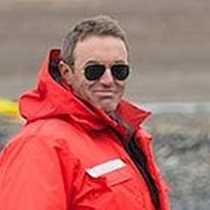Cape Horn
After the calmest crossing of the Drake Passage imaginable, we approached the infamous Cape Horn late this morning. Rather than tempest-tossed seas and raging gales, we met with nearly flat, calm conditions - ideal for viewing this southernmost piece of land in the Americas. Albatross soared around the vessel and a few Commerson's dolphins were spotted, briefly riding our bow. The green and brown island under overcast skies presented an almost surreal contrast to the black and white landscape of the south, glistening under the nearly constant sunshine we have experienced.
The rounding of Cape Horn through the Drake Passage has been notoriously difficult ever since the first Europeans ventured into these waters. Ferdinand Magellan discovered the Strait that bears his name in 1520, on his epic circumnavigation of the globe. Not until 1578 did mariners realize that Tierra del Fuego was not part of the great southern continent, but merely a middling sized island. During the first British circumnavigation of the world, Francis Drake passed through the waterway Magellan had discovered, and upon reaching the Pacific met a terrific storm which drove his ships far to the south and east. 'Drake's Passage' was discovered. The English buccaneer was blown so far out to sea that he never laid eyes on the islands south of Tierra del Fuego. The sighting and naming of the Cape came nearly 40 years later. The Low Countries broke away from Spanish rule while Drake was still at sea, and quickly became a major seafaring power. By 1602 the Dutch East India Company had been formed, and soon forbid any but their own ships from using the Straits of Magellan. Issac le Maire, a renegade Amsterdam merchant, decided to seek out Drake's discovery. He sent two ships out in 1615, Hoorn and Eendracht, under the command of brothers Wilhelm and Jan Schouten. Hoorn was lost along the coast of Patagonia, but Eendracht continued and on January 29th, 1616 became the first ship to 'round the Horn'. Wilhelm Schouten named this southernmost island Kaap Hoorn after his birthplace in northern Holland.
Today the island belongs to Chile, which maintains a small weather station and lighthouse ashore. We enjoyed great views of the southern shore of the island, before turning north towards the mouth of the Beagle Channel for our tranquil transit to Ushuaia. Our spectacular good fortune with the weather would be the envy of Magellan, Drake and all those who followed them.
After the calmest crossing of the Drake Passage imaginable, we approached the infamous Cape Horn late this morning. Rather than tempest-tossed seas and raging gales, we met with nearly flat, calm conditions - ideal for viewing this southernmost piece of land in the Americas. Albatross soared around the vessel and a few Commerson's dolphins were spotted, briefly riding our bow. The green and brown island under overcast skies presented an almost surreal contrast to the black and white landscape of the south, glistening under the nearly constant sunshine we have experienced.
The rounding of Cape Horn through the Drake Passage has been notoriously difficult ever since the first Europeans ventured into these waters. Ferdinand Magellan discovered the Strait that bears his name in 1520, on his epic circumnavigation of the globe. Not until 1578 did mariners realize that Tierra del Fuego was not part of the great southern continent, but merely a middling sized island. During the first British circumnavigation of the world, Francis Drake passed through the waterway Magellan had discovered, and upon reaching the Pacific met a terrific storm which drove his ships far to the south and east. 'Drake's Passage' was discovered. The English buccaneer was blown so far out to sea that he never laid eyes on the islands south of Tierra del Fuego. The sighting and naming of the Cape came nearly 40 years later. The Low Countries broke away from Spanish rule while Drake was still at sea, and quickly became a major seafaring power. By 1602 the Dutch East India Company had been formed, and soon forbid any but their own ships from using the Straits of Magellan. Issac le Maire, a renegade Amsterdam merchant, decided to seek out Drake's discovery. He sent two ships out in 1615, Hoorn and Eendracht, under the command of brothers Wilhelm and Jan Schouten. Hoorn was lost along the coast of Patagonia, but Eendracht continued and on January 29th, 1616 became the first ship to 'round the Horn'. Wilhelm Schouten named this southernmost island Kaap Hoorn after his birthplace in northern Holland.
Today the island belongs to Chile, which maintains a small weather station and lighthouse ashore. We enjoyed great views of the southern shore of the island, before turning north towards the mouth of the Beagle Channel for our tranquil transit to Ushuaia. Our spectacular good fortune with the weather would be the envy of Magellan, Drake and all those who followed them.




